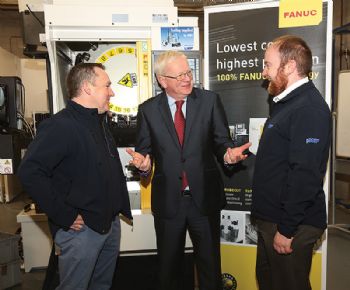
Limerick Institute of Technology (LIT) has close ties with the precision engineering sector in Ireland and constantly develops training programmes that meet the needs of existing and emerging industries there.
Most recently, LIT saw that there was a shortage of graduates capable of maximising the use of modern CNC machines and introduced a course designed to address this shortcoming.
As a long-time supporter of the education sector, Sheffield-based WNT (UK) Ltd (
www.wnt.com) was happy to become involved by providing tooling and technical support for the new course, which LIT operates on either a full- or part-time basis.
Ciaran O’Loughlin, a lecturer at LIT, said: “This flexibility allows the precision engineering sector to grow, knowing that it will have students graduating as fully fledged engineers, with industry experience and competence in the latest technologies.
“Our students will be in great demand and will have employment opportunities across the medical, oil and gas, aerospace and general engineering sectors.”
The content of the LIT course includes advanced CNC machining, materials science, metrology and six sigma, along with the advanced engineering technology, process planning, maths and science required to become a competent engineer.
Some 70 students will make use of the facility this year, with first-year students learning how to program using ISO G-coding and Manual Guide i control. Second-year students will move on to using SolidCAM, while third-year students will develop their knowledge of high-speed machining.
In-depth support
The support provided by WNT (UK) for this programme amounts to much more than just ‘tooling up a machining centre’. Applications sales engineer Shane O’Donnell and technical sales engineer Jerry Warren also provide support for LIT’s industry partners.
Mr O’Loughlin says: “One example of this collaboration was a demonstration of the high-speed dry machining of steel during a meeting of the Precision Turned Parts Manufacturing Association — the PTMA — which we host on a regular basis. These are all experienced machinists, and they were most impressed by the demonstration; many have since investigated this technology further.”
The application support provided by Mr O’Donnell and Mr Warren ensures that the tooling at LIT is used to its maximum potential.
Typically, this involves explanations of cutting-tool geometry and cutting data, as well as highlighting the benefits of modern work-holding solutions, the aim being to enable LIT students to run CNC machines with confidence.
Mr O’Loughlin added: “It is pleasing to note that Mr O’Donnell graduated from our mechanical engineering programme while working for a local company — Takumi Precision Engineering.”
Over the last three years, LIT has invested over 600,000 euros in precision-engineering-related technology. The first tranche of this went towards metrology and SPC equipment, followed by the installation of a CMM and a vision-based measurement system — and other equipment that allows LIT to train its students to the standards they will need in industry.
Latest technology
The CNC machine tools in place are a Fanuc Robodrill α-D21SiA5 machining centre, a Spinner U620 five-axis machining centre, and a Mazak twin-spindle lathe with driven tooling and a Y axis. Initially, the equipment from WNT — worth about 30,000 euros — will be used exclusively on the Fanuc Robodrill.
This includes a WNT Zero Point baseplate, WNT ZSG Centric vice and ESG Mini vice systems, along with a selection of cutting tools — solid-carbide end mills for steel and light alloys, ball-nose cutters, indexable-insert milling systems, drills, taps and tool-holders (the latter includes standard ER collet and WNT’s high-performance Centro P system).

WNT’s Mr O’Donnell said: “The facility at LIT is impressive, and it is a pleasure to be so heavily involved with it. WNT places great emphasis on training the future generation of engineers, and the enthusiasm at LIT is reassuring.
“With the Fanuc Robodrill, we can demonstrate the benefits of modern cutting tools; and because the machine is fitted with video equipment, we can spread that message even further afield via YouTube.
“The Fanuc Robodrill is ideal for this type of demonstration, as it is a high-speed model with a 24,000rev/min 4.7kW spindle and feed rates up to 30m/min. It is controlled by the latest Fanuc 31i-B5 CNC system.”
LIT is also promoting itself to the wider education community, with over 500 ‘second-level schools’ seeing the WNT tooling in action during an Engineering Week, where students were shown high-speed milling using trochoidal milling strategies, programmed through SolidCAM.
Mr O’Loughlin said: “The impression left on these students was immense. Most had not seen a CNC machine before, and they certainly had never seen metal removed at such a rate. We also have evenings for engineering teachers, during which we stress the importance of promoting the future of engineering.
“The Engineering Technology Teachers Association has a long history with LIT, and connecting with it helps to keep teachers up to date with technology.
“The need to connect with ‘third-level education’ in Ireland became very apparent to the PTMA, due to the shortage of skilled technical staff. We worked with the association to develop industry-driven precision engineering programmes; within a nine-month period, LIT had created the courses that industry needed.”
This partnership continues, with LIT hosting the quarterly meetings of the PTMA. At a recent one, Adrian Fitts — WNT (UK)’s business development manager — presented a talk on new machining strategies; Mr O’Donnell then demonstrated these with the high-speed machining of steel and aluminium.